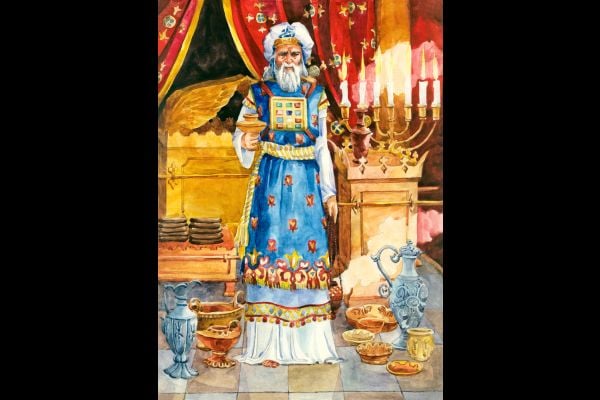“Clothes make the Jew.”
By Rabbi Ari Enkin, Rabbinic Director, United with Israel
This week’s Torah portion is “Tetzaveh” (Exodus 27:20-30:10) and in it we read about the special and holy clothes that the Priests and High Priest would wear when serving in the Temple. So on that note, let’s learn about these special clothes and then move into a discussion about the Jewish view on clothing in general.
The common priests and high priests were required to wear special clothing when performing their service in the Holy Temple. These clothes were meant to command respect and reverence for the priests and the services they performed. Clothes assist the wearer in commanding respect, and as such, even a rabbi, as one who represents God and Torah, must dress in a dignified manner, as well.
The common priests wore four garments, while the High Priest (Kohen Gadol) wore eight garments – the “regular” four plus an additional four.
The four basic garments were the “Ketonet,” a long linen tunic that reached the heels, the “Avnet,” a long colorful sash that was wrapped around the waist, the “Migbaat,” a linen turban wound around the head, and the “Michnasayim,” linen trousers.
The High Priest’s additional clothing was:
• The “Choshen,” a breastplate made of cloth which was worn over the chest. It contained 12 stones, each engraved with the name of one of the 12 Tribes.
• The “Ephod,” a type of apron made from blue, purple, and red wool with gold fibers weaved in.
• The “Meil,” a robe made of blue wool worn under the ephod. The bottom of the Meil was famously decorated with alternating bells and “pomegranates” made from blue, purple, and crimson wool.
• The “Tzitz”, a golden plate engraved with the words: “Holy to God,” worn around the forehead
These may have been the very first ritual garments that the Jewish people had.
Some later and well-known ritual garments are the tallit and kippa.
The tallit is a prayer shawl worn while reciting the morning prayers. In most Ashkenazi communities, a tallit is worn only after marriage. The most important feature of the tallit are the uniquely tied and knotted strings at each of its four corners knows as the “tzitzit.”
There is a small version of the tallit known as a “tallit kattan” (“the small tallit”) which is worn under one’s clothes by observant Jewish males all day long.
The kippa (or yarmulke), or course, is a thin, slightly rounded skullcap worn by observant men at all times. By wearing a kippa one acknowledges that there is a God above us. Married observant women also cover their heads, but this is done as a sign that they are married.
A lesser known and lesser seen ritual garment is the “kittel”. The Kittel a white, long, cotton robe worn by many Orthodox Jews on the High Holidays. The whiteness is said to be a sign of purity, an important theme during the high holiday season. Many wear the kittel at the Passover seder, as well. In many Ashkenazi Orthodox circles, it is customary for the groom to wear a kittel under the chuppah.
Although not necessarily “ritual garments” one is to wear one’s finest clothes in honor of Shabbat and Holidays. They should be reserved exclusively for Shabbat and Holiday wear and be of higher quality and cost than one’s weekday clothing.
Indeed, we are told not to wear any of our Shabbat clothes on weekdays nor any of our weekday clothes on Shabbat. Separate belts, socks, shoes, and even perfumes are all in order in honor of Shabbat. Some say that one should even have separate pajamas for Shabbat use. One should don one’s Shabbat clothes after showering on Friday in honor of Shabbat and one should remain dressed in Shabbat clothing until at least after Havdalah is recited upon Shabbat’s conclusion.
Our sages teach us that one should always be dressed nicely because one’s appearance and manner of dress reveals one’s true character. One should tuck one’s shirt into one’s pants and not look sloppy.
In the words of Rabbi Berel Wein, “The idea of proper dress, dress that brings honor and glory to those who wear the clothing, and to the society that views that clothing, is central to Jewish life and values. Clothes that are provocative, that are vulgar and insulting to others, that are physically immodest and meant to attract anti-social response, are all frowned upon by Jewish tradition. There need not be specific uniforms in the Jewish street but modest, clean, and attractive dress should be the rule for our society. In that sense, perhaps we can all agree that clothes do make the Jew.”
For more insights by Rabbi Enkin on this week’s Torah portion, click on the links below.
How Do You Know When the Time is Right?
A Lesson in Education from the Lighting of the Menorah
Learning About Common Courtesy from the Holiest Person on Earth
Do You Love Israel? Make a Donation - Show Your Support!
Donate to vital charities that help protect Israeli citizens and inspire millions around the world to support Israel too!
Now more than ever, Israel needs your help to fight and win the war -- including on the battlefield of public opinion.
Antisemitism, anti-Israel bias and boycotts are out of control. Israel's enemies are inciting terror and violence against innocent Israelis and Jews around the world. Help us fight back!



